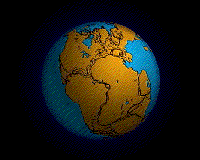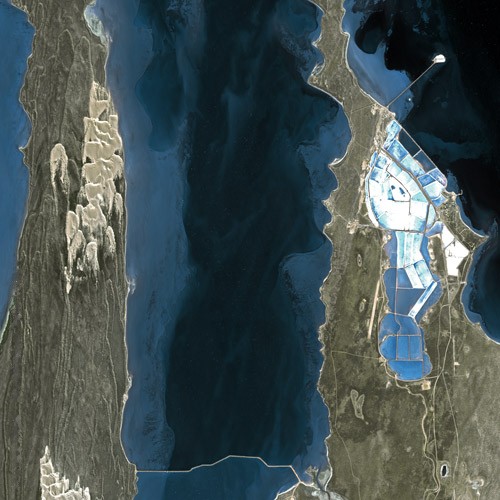|
Coquina
Coquina () is a sedimentary rock that is composed either wholly or almost entirely of the transported, abraded, and mechanically sorted fragments of mollusks, trilobites, brachiopods, or other invertebrates. The term ''coquina'' comes from the Spanish language, Spanish word for "cockle (bivalve), cockle" and "shellfish". For a sediment to be considered to be a coquina, the particles composing it should average or greater in size. Coquina can vary in hardness from poorly to moderately cementation (geology), cemented. Incompletely consolidated and poorly cemented coquinas are considered grainstones in the Dunham classification system for carbonate sedimentary rocks. A well-cemented coquina is classified as a biosparite (fossiliferous limestone) according to the Folk classification, Folk classification of sedimentary rocks. Coquinas accumulate in high-energy marine and Lacustrine deposits, lacustrine environments where currents and waves result in the vigorous winnowing, abrasion, ... [...More Info...] [...Related Items...] OR: [Wikipedia] [Google] [Baidu] |
Campos Basin
The Campos Basin is one of 12 coastal sedimentary basins of Brazil. It spans both onshore and offshore parts of the South Atlantic with the onshore part located near Rio de Janeiro. The basin originated in Neocomian stage of the Cretaceous period 145–130 million years ago during the breakup of Gondwana. It has a total area of about , with the onshore portion small at only . Etymology The basin is named after the Campos dos Goytacazes city. Description The Campos Basin is bound on the south by the Cabo Frio High, separating the basin from the Santos Basin and on the north by the Vitória High, forming the boundary with the Espírito Santo Basin. Campos Basin contains the Paraiba do Sul River delta. Tectonic history The South Atlantic margin developed on Archean stable cratons consisting of hard and resistant rocks and partly on the Neoproterozoic mobile belts composed of less resistant metamorphic rocks.Clemente, 2013, p.3 The Precambrian basement of the San ... [...More Info...] [...Related Items...] OR: [Wikipedia] [Google] [Baidu] |
Sedimentary Rock
Sedimentary rocks are types of rock (geology), rock formed by the cementation (geology), cementation of sediments—i.e. particles made of minerals (geological detritus) or organic matter (biological detritus)—that have been accumulated or deposited at Earth's surface. Sedimentation is any process that causes these particles to settle in place. Geological detritus originates from weathering and erosion of existing rocks, or from the solidification of molten lava blobs erupted by volcanoes. The geological detritus is transported to the place of deposition by water, wind, ice or Mass wasting, mass movement, which are called agents of denudation. Biological detritus is formed by bodies and parts (mainly shells) of dead aquatic organisms, as well as their fecal mass, suspended in water and slowly piling up on the floor of water bodies (marine snow). Sedimentation may also occur when dissolved minerals precipitate from aqueous solution, water solution. The sedimentary rock cover of ... [...More Info...] [...Related Items...] OR: [Wikipedia] [Google] [Baidu] |
Shark Bay
Shark Bay () is a World Heritage Site in the Gascoyne region of Western Australia. The area is located approximately north of Perth, on the westernmost point of the Australian continent. UNESCO's listing of Shark Bay as a World Heritage Site reads: The bay features Australia's most abundant marine ecosystems. It is a popular fishing spot. History The record of Indigenous Australians, Australian Aboriginal occupation of Shark Bay extends to years Before Present, BP. At that time most of the area was dry land, and rising sea levels flooded Shark Bay between BP and BP. A considerable number of Aboriginal midden sites have been found, especially on Peron Peninsula and Dirk Hartog Island, which provide evidence of some of the foods gathered from the waters and nearby land areas. An expedition led by Dirk Hartog happened upon the area in 1616, becoming the second group of Europeans known to have visited Australia, after the crew of ''Duyfken'' under Willem Janszoon had visi ... [...More Info...] [...Related Items...] OR: [Wikipedia] [Google] [Baidu] |
Anglicanism
Anglicanism, also known as Episcopalianism in some countries, is a Western Christianity, Western Christian tradition which developed from the practices, liturgy, and identity of the Church of England following the English Reformation, in the context of the Protestant Reformation in Europe. It is one of the largest branches of Christianity, with around 110 million adherents worldwide . Most are members of national or regional Ecclesiastical province#Anglican Communion, ecclesiastical provinces of the international Anglican Communion, one of the largest Christian bodies in the world, and the world's third-largest Christian communion. When united and uniting churches, united churches in the Anglican Communion and the breakaway Continuing Anglican movement were not counted, there were an estimated 97.4 million Anglicans worldwide in 2020. Adherents of Anglicanism are called ''Anglicans''; they are also called ''Episcopalians'' in some countries. The provinces within the Anglican ... [...More Info...] [...Related Items...] OR: [Wikipedia] [Google] [Baidu] |
Old Pearler Restaurant In Denham
Old or OLD may refer to: Places *Old, Baranya, Hungary *Old, Northamptonshire, England *Old Street station, a railway and tube station in London (station code OLD) *OLD, IATA code for Old Town Municipal Airport and Seaplane Base, Old Town, Maine, United States People *Old (surname) Music *OLD (band), a grindcore/industrial metal group * ''Old'' (Danny Brown album), a 2013 album by Danny Brown * ''Old'' (Starflyer 59 album), a 2003 album by Starflyer 59 * "Old" (song), a 1995 song by Machine Head *"Old", a 1982 song by Dexys Midnight Runners from ''Too-Rye-Ay'' Other uses * ''Old'' (film), a 2021 American thriller film *''Oxford Latin Dictionary'' *Online dating *Over-Locknut Distance (or Dimension), a measurement of a bicycle wheel and frame See also *Old age *List of people known as the Old *''Old LP'', a 2019 album by That Dog * * *Olde, a list of people with the surname *Olds (other) Olds may refer to: People * The olds, a jocular and irreverent online nick ... [...More Info...] [...Related Items...] OR: [Wikipedia] [Google] [Baidu] |
Fragum Erugatum
Fragum is a genus of cockles, marine bivalve molluscs in the family Cardiidae. Members of the genus have characteristic thick, sculptured shells and live buried in sand, extending their siphons to the surface to feed and breathe. They are found in the Indo-Pacific region and the Red Sea. Species The genus includes the following species according to the World Register of Marine Species: *'' Fragum erugatum'' (Tate, 1889) *'' Fragum fragum'' (Linnaeus, 1758) *''Fragum funafutiense'' (Ter Poorten & Middelfart, 2021) *''Fragum grasi'' (Ter Poorten, 2009) *''Fragum loochooanum'' (Kira, 1959) *''Fragum mundum'' ( Reeve, 1845) *'' Fragum nivale'' ( Reeve, 1845) *''Fragum scruposum'' (Deshayes, 1855) *''Fragum sueziense'' ( Issel, 1869) *'' Fragum unedo'' (Linnaeus Carl Linnaeus (23 May 1707 – 10 January 1778), also known after ennoblement in 1761 as Carl von Linné,#Blunt, Blunt (2004), p. 171. was a Swedish biologist and physician who formalised binomial nomenclature, t ... [...More Info...] [...Related Items...] OR: [Wikipedia] [Google] [Baidu] |
Denham, Western Australia
Denham is the administrative town for the Shire of Shark Bay, Western Australia. At the 2016 census, Denham had a population of 754. Material was copied from this source, which is available under Creative Commons Attribution 4.0 International License Located on the western coast of the Peron Peninsula north of Perth, Denham is the westernmost publicly accessible town in Australia, and is named in honour of Captain Henry Mangles Denham of the Royal Navy, who charted Shark Bay in 1858. Today, Denham survives as the gateway for the tourists who come to see the dolphins at Monkey Mia, which is located northeast of the town. The town also has an attractive beach and a jetty popular with those interested in fishing and boating. The Denham region was the second area of the Australian mainland discovered by European sailors, after the western coast of Cape York Peninsula. History On 25 October 1616, Dutch explorer Dirk Hartog and crew came unexpectedly upon "various islands, whi ... [...More Info...] [...Related Items...] OR: [Wikipedia] [Google] [Baidu] |
Facies
In geology, a facies ( , ; same pronunciation and spelling in the plural) is a body of rock with distinctive characteristics. The characteristics can be any observable attribute of rocks (such as their overall appearance, composition, or condition of formation) and the changes that may occur in those attributes over a geographic area. A facies encompasses all the characteristics of a rock including its chemical, physical, and biological features that distinguish it from adjacent rock. The term "facies" was introduced by the Swiss geologist Amanz Gressly in 1838 and was part of his significant contribution to the foundations of modern stratigraphy, which replaced the earlier notions of '' Neptunism''. Walther's law Walther's law of facies, or simply Walther's law, named after the geologist Johannes Walther, states that the vertical succession of facies reflects lateral changes in environment. Conversely, it states that when a depositional environment "migrates" laterally, ... [...More Info...] [...Related Items...] OR: [Wikipedia] [Google] [Baidu] |
Pleistocene
The Pleistocene ( ; referred to colloquially as the ''ice age, Ice Age'') is the geological epoch (geology), epoch that lasted from to 11,700 years ago, spanning the Earth's most recent period of repeated glaciations. Before a change was finally confirmed in 2009 by the International Union of Geological Sciences, the cutoff of the Pleistocene and the preceding Pliocene was regarded as being 1.806 million years Before Present (BP). Publications from earlier years may use either definition of the period. The end of the Pleistocene corresponds with the end of the last glacial period and also with the end of the Paleolithic age used in archaeology. The name is a combination of Ancient Greek () 'most' and (; Latinized as ) 'new'. The aridification and cooling trends of the preceding Neogene were continued in the Pleistocene. The climate was strongly variable depending on the glacial cycle, oscillating between cold Glacial period, glacial periods and warmer Interglacial, int ... [...More Info...] [...Related Items...] OR: [Wikipedia] [Google] [Baidu] |
Devonian
The Devonian ( ) is a period (geology), geologic period and system (stratigraphy), system of the Paleozoic era (geology), era during the Phanerozoic eon (geology), eon, spanning 60.3 million years from the end of the preceding Silurian period at million years ago (Megaannum, Ma), to the beginning of the succeeding Carboniferous period at Ma. It is the fourth period of both the Paleozoic and the Phanerozoic. It is named after Devon, South West England, where rocks from this period were first studied. The first significant evolutionary radiation of history of life#Colonization of land, life on land occurred during the Devonian, as free-spore, sporing land plants (pteridophytes) began to spread across dry land, forming extensive coal forests which covered the continents. By the middle of the Devonian, several groups of vascular plants had evolved leaf, leaves and true roots, and by the end of the period the first seed-bearing plants (Pteridospermatophyta, pteridospermatophyt ... [...More Info...] [...Related Items...] OR: [Wikipedia] [Google] [Baidu] |
Coral
Corals are colonial marine invertebrates within the subphylum Anthozoa of the phylum Cnidaria. They typically form compact Colony (biology), colonies of many identical individual polyp (zoology), polyps. Coral species include the important Coral reef, reef builders that inhabit tropical oceans and secrete calcium carbonate to form a hard skeleton. A coral "group" is a colony of very many cloning, genetically identical polyps. Each polyp is a sac-like animal typically only a few millimeters in diameter and a few centimeters in height. A set of tentacles surround a central mouth opening. Each polyp excretes an exoskeleton near the base. Over many generations, the colony thus creates a skeleton characteristic of the species which can measure up to several meters in size. Individual colonies grow by asexual reproduction of polyps. Corals also breed sexually by spawning: polyps of the same species release gametes simultaneously overnight, often around a full moon. Fertilized eggs form ... [...More Info...] [...Related Items...] OR: [Wikipedia] [Google] [Baidu] |





